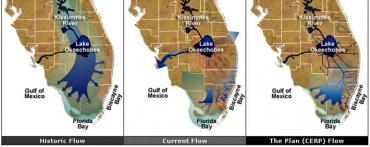
If Thursday's South Florida Water Management Board meeting in Fort Myers sounded like deja vu all over again, that's because the annual "buy land, move the water south" campaign is back.
It's like clockwork. Concerned citizens and activists come to shout and demand. People are scared, I get it. Who wants to visit or live along an estuary that could make them sick? We've had a lot of rain, a lot of Lake Okeechobee discharges. Algae blooms along the Caloosahatchee and St. Lucie rivers are back.
But I wish when folks attend these SFWMD meetings, they would spend the time they're not talking watching and listening -- I mean, really listening -- to the district's presentations.
Certainly the answers they didn't want to hear were right there. All they had to do Thursday was follow along with agenda item 29 -- just pay attention.
 But here's the short form again: Scientists won't know how much more storage will be needed until they see how the currently planned projects are built and operating.
But here's the short form again: Scientists won't know how much more storage will be needed until they see how the currently planned projects are built and operating.
That means no reservoir, and any plan for one right now would be foolish.
"This may be an inconvenient truth to activists whose mantra is ‘buy the land, send the water south,’" said U.S. Sugar Senior Vice President Malcolm "Bubba" Wade, Jr. "But the fact is, there are already 120,000 acres of formerly productive farmland that are now in public ownership for water storage and restoration efforts, and the use of these lands has not been maximized by the government yet."
Wade wrote this as part of an answer to a guest column by Audubon Florida Executive Director Eric Draper in the Fort Myers News-Press ("Legislators, state need plan to store water" ). Draper is one of the hornblowers for the "buy land, move the water south" cause.
The Interagency Restoration Task Force, made up of state and federal partners, is in charge of restoration. It formalized the long-term integrated delivery schedule in November 2015, which charts the course of restoration efforts through 2030. Read this Sun-Sentinel guest column by Col. Jason Kirk, Jacksonville district commander, U.S. Army Corps of Engineers.
And restoration is all on schedule. The state has its components on a fast track, water is already "flowing south," albeit minimally. Why on earth would we want to lose our focus, spend millions of dollars on land we may not -- in fact, probably don't -- need, and delay our progress to integrate a politically expedient reservoir "plan" into CERP before we know exactly how everything is working?
I blame the self-appointed pied pipers of Everglades plumbing, the Everglades Foundation, for playing on South Floridians' fears.
The Foundation has managed to take advantage of redrawn districts and a mercurial voter mood in an unpredictable election year to get prominent state legislators on their side. Earlier this week Sen. Lizbeth Benacquisto, R-Fort Myers, and Sen. Joe Negron, R-Stuart, sent letters to the SFWMD asking board members to give more consideration to buying land south of Lake Okeechobee for future water storage.
Negron, by the way, is the senator who doesn't believe in forcing septic tank inspections or sewer conversions on anyone.
Add to that L. Kevin Stinnette, Indian riverkeeper, who has written a letter to Peter Antonacci, head of the SFWMD, demanding sugar farmers suspend pumping water off their crops and into canals. Huh? When a Stuart reporter asked her about it, U.S. Sugar Corp. spokesperson Judy Sanchez snapped, "So I guess wealthy coastal residents deserve more protection from harm than the jobs and livelihoods of people in the farming communities."
The Everglades Foundation, meanwhile, and the environmental organizations that buy into EF's "science," would like to be considered the only worthy brains involved in Everglades restoration.
But please remember, it took nearly five years to get CERP back on track after the Everglades Foundation signed off on halting construction on the 16,700-acre A1 reservoir (south of Lake Okeechobee) when they thought Charlie Crist was going to buy out U.S. Sugar. In fact, the reservoir had been partially dismantled.
With or without a reservoir, the folks who live on the coasts east and west of the big lake are never going to "store" their way out of their water problem. But it's in their power to solve a big portion of it: Convert their septic tanks to a central sewer system. "The real challenge is local," board member Melanie Peterson said of Martin County. "Something like 80 percent of the impact on the river comes from septic tanks."
Oh, yes -- and if the Everglades Foundation and all the folks who follow behind want to do something truly important for sick waterways, trying to pull off a land grab isn't it. But leaning on the U.S. Army Corps of Engineers to fix the Herbert Hoover Dike ... now you're talking.
Reach Nancy Smith at nsmith@sunshinestatenews.com or at 228-282-2423. Twitter: @NancyLBSmith


